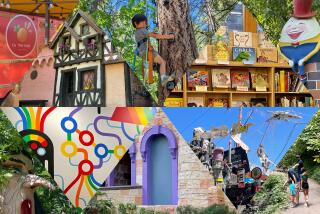MARY LAINE YARBER : Helping Children Get the Most Mileage From Summer Vacation
If youâre going away on vacation with your child this summer, there are some easy things you can do to make the experience an educational one.
First, tell the child what you know about the destination and your reasons for going. Describe the sights and activities youâre looking forward to, and then ask what the child would like to see or do.
Books can help children learn even more about the geography, history, arts and culture of your destination.
I recommend the âKidding Aroundâ series for grade-school kids. It includes books and other materials covering many popular cities such as Chicago, Atlanta, Paris and London. Each âKidding Aroundâ paperback is illustrated and costs about $10.
Another good series, the âInsight Guides,â is aimed at a teen-age audience. Each of its approximately 100 books, all with abundant color photos, offers an overview of the history and culture of a city or country. The series emphasizes European cities, but also features other places such as Crete, Bangkok, Pakistan, Leningrad and Yemen. Each paperback volume costs $19.95.
For a bigger perspective on travel and the world, try a childrenâs atlas. The âRand McNally Childrenâs World Atlasâ has excellent maps, drawings, photos and a thorough index. It costs $14.95 in hardcover.
If possible, share with your son or daughter some of the areaâs culture--such as music, art, dress and food--before you go.
Children are usually fascinated with flags, so show the cityâs or countryâs flag, then explain the history behind its colors or symbols.
Spend some time going over maps with your child. Start with the big picture, pointing out where you live, then your destination.
Ask some questions. For example, is the place east or west of home? How far is it? What other cities or nations will you fly over or pass through on the way? Will you cross a time zone? What kinds of physical features, such as lakes and mountains, are visible?
Then trace the travel route on the map or globe with a pen or pencil, explaining how long you will stay and what you will do at each stop.
During the actual trip, a travel journal is a fine learning tool. You can buy a blank journal in a bookstore, but I suggest making one so you can tailor it to your trip and your child.
Just buy an inexpensive spiral notebook and tie a pen to it. Then write a different topic at the top of each page for each day of the vacation.
Some possible topics: Whatâs the hardest part of traveling? List some similarities and differences between this culture and your own. Whatâs your favorite thing about this place or culture? Describe some interesting people you have seen or met. What do you miss most about home, and why?
Besides writing, ask the child to draw pictures of places or people, and to record his or her expenditures, if any.
Once youâve returned home, post a map on the wall and let your child retrace, with colored pens or thumbtacks, your route.
And remember that children seem to quickly forget where they have been or what they have done. So in the next year, go over the travel journal now and then with your child. This will help make the learning and memories more permanent.
My favorite place for maps, travel books and other related learning materials is the California Map and Travel Center in Santa Monica or the Automobile Club of Southern California.
More to Read
Sign up for The Wild
Weâll help you find the best places to hike, bike and run, as well as the perfect silent spots for meditation and yoga.
You may occasionally receive promotional content from the Los Angeles Times.






